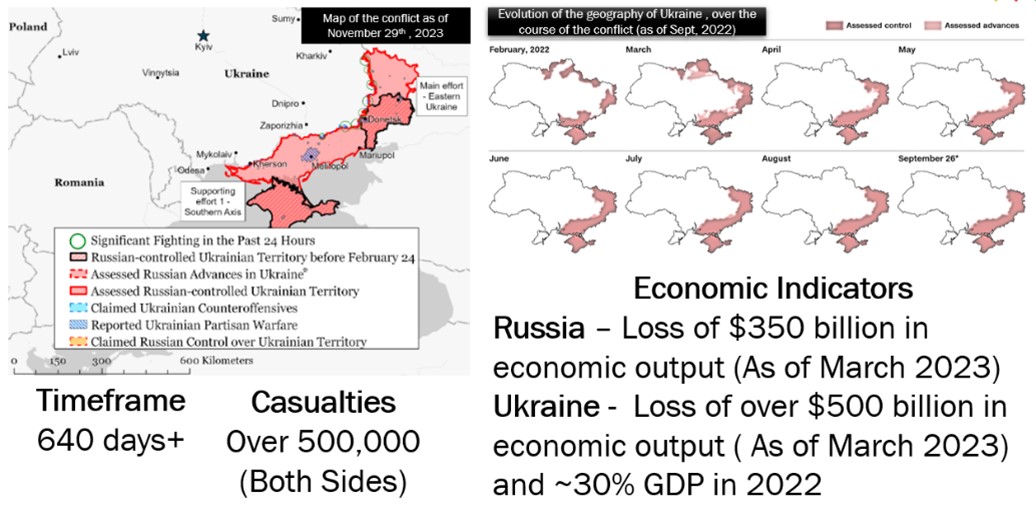Key 2023 Trends Covered in the Study:
•Continuation of Russia-Ukraine Conflict
As of November, 2023, the conflict has spanned 640 days. The Russia-Ukraine conflict caused significant economic losses: Russia faced a $350 billion output decrease, as of March 2023, while Ukraine suffered a $500 billion loss and a 30% GDP reduction as of March 2023. In the aerospace and defense markets, the ongoing conflict has created substantial disruptions, particularly in the space industry. While the International Space Station (ISS) program appears safeguarded despite initial threats from Russia, other space programs across the globe face considerable uncertainties and setbacks. The complex ripple effects from disruptions across the segments, have significantly impacted the global defense supply chain. Commercial aviation faced airspace embargoes, with the EU, UK, and US prohibiting Russian aircraft, leading to route diversions for 36 countries. These complexities underline the extensive repercussions of the conflict, intertwining economic downturns and sectoral disruptions. The conflict has led to several other notable consequences. Firstly, there is a global and regional escalation in jet fuel prices, coupled with a reduction in freight capacity in the European region. Additionally, transportation and logistics operations have been significantly disrupted, impacting multiple value chains and the availability of key resources, including titanium, nickel, neon, and palladium. Lastly, the space industry is experiencing severe disruptions, particularly with the cessation of Soyuz cooperation with Western space organizations, resulting in the cancellation of numerous Russian launches.
Inquire Before Buying @ https://www.marketsandmarkets.com/Enquiry_Before_BuyingNew.asp?id=153569545
•Increase in Defense Spending
Against the backdrop of current geopolitical conflicts involving Russia, Ukraine, Israel, and Palestine, coupled with escalating tensions from key players such as China and North Korea, there is a notable surge in global insecurity concerns. This has led to an upswing in defense spending by nations worldwide, with an annual growth rate of 3.7% in 2022, approaching an unprecedented peak of US $2240 billion.
Remarkably, despite the substantial economic challenges faced globally in 2020 due to the pandemic and inflation, defense spending defied expectations by continuing to rise. This underscores the significant emphasis placed on defense, even during periods of economic downturn.
The top five spenders in 2022-23 were the United States(39.1%), China(13.0%), Russia(3.8%), India(3.6%), and Saudi Arabia(3.3%), collectively contributing to 63% of global military expenditure. This trend highlights the strategic priority nations are assigning to bolstering their defense capabilities in the current geopolitical landscape.
Key 2024 Trends Covered in the Study:
•Increasing Investment in Autonomous Weapons
Weapons are evolving towards autonomy through technological advancements and artificial intelligence. Notable instances include the inaugural deployment of autonomous weapons in the Ukrainian battlefield, where AI-equipped drones can independently identify and engage targets without human intervention. Additionally, Anduril Industries’ autonomous system, the Roadrunner, stands out as a reusable aircraft capable of vertical takeoff, carrying diverse payloads, and intercepting and neutralizing airborne threats. This system has successfully secured a contract with a U.S. customer.
In the ongoing conflict with Ukraine, Russia has repeatedly employed the KUB-BLA Drone, an autonomous munition created by Kalashnikov and Zala Aero Group. This drone utilizes AI Visual Identification (AIVI) technology to instantly recognize and classify targets, ensuring precise strikes in real-time. The Israeli military has employed the Harpy in multiple instances. Harpy is an autonomous loitering munition manufactured by Israel Aerospace Industries, designed to detect, and destroy radar emitters with minimal human intervention. During the Libyan Conflict (2011-present), the Kargu-2, an autonomous drone manufactured in Turkey, has been reportedly utilized to target soldiers aligned with General Khalifa Haftar. In January 2020, Qasem Soleimani, the commander of the Iranian Quds Force, was targeted and killed, by the US military using the Autonomous MQ-9 Reaper Platform.
Browse For More Details @
https://www.marketsandmarkets.com/Market-Reports/global-defense-industry-outlook-153569545.html
•MoD’s Focusing on Migration to Hydrogen Fuel
The evolving landscape of global defense strategies, particularly within NATO, underscores a fundamental shift towards bolstering energy resilience and reducing reliance on conventional fossil fuels. Historically, energy security focused on diversifying oil and gas sources. NATO’s strategic pivot now centers on renewable energy sources, particularly hydrogen, as a pivotal element to enhance energy efficiency and mobility in military operations across aviation, maritime, and terrestrial logistics. This transition not only aligns with sustainability goals but also fortifies the resilience of armed forces, by ensuring access to reliable alternative energy sources.
Hydrogen, considered a linchpin for energy security and national resilience, has prompted leading nations like Germany, Japan, and the United States to pioneer hydrogen technology integration within their defense structures. Germany’s Bundeswehr, for instance, actively explores hydrogen-powered vehicles, highlighting benefits such as reduced environmental impact and heightened energy independence. Japan’s Defense Ministry strategically embraces hydrogen fuel cell technology, leveraging its clean energy attributes across various applications, including mobile power generation and unmanned vehicles. The United States, through its military branches, is also incrementally showing interest in hydrogen fuel, primarily experimenting with alkaline hydrogen fuel cells to power tactical vehicles. However, despite the promising potential of Power to Hydrogen (P2H) technology, various obstacles impede its widespread adoption, hindering the development of the P2H market. Challenges such as infrastructure limitations, cost considerations, and technological advancements remain focal points requiring concerted efforts from governments, industries, and research institutions to surmount.
Media Contact
Company Name: MarketsandMarkets™ Research Private Ltd.
Contact Person: Mr. Aashish Mehra
Email: Send Email
Phone: 18886006441
Address:630 Dundee Road Suite 430
City: Northbrook
State: IL 60062
Country: United States
Website: https://www.marketsandmarkets.com/Market-Reports/global-defense-industry-outlook-153569545.html


